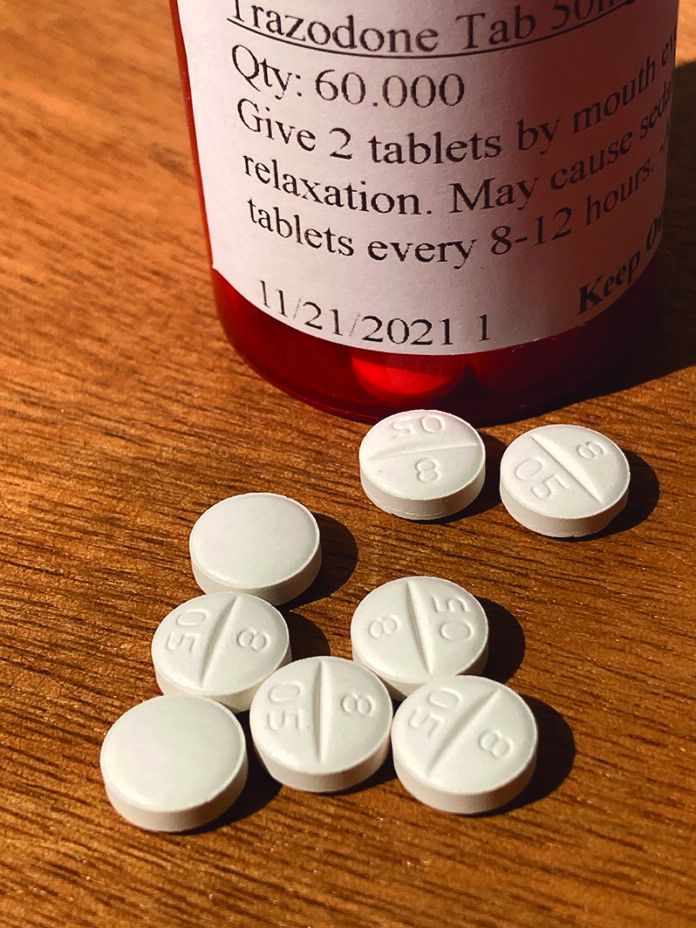
Trazodone is an anxiolytic (anti-anxiety) medication that is also used for short-term sedation. It’s not classified as an analgesic (pain-relieving medication), so why are we seeing it prescribed more and more as part of comprehensive, combination pain protocols for dogs?
One possible reason is because pain has an emotional aspect. The somatosensory (physical) component of pain has to do with the location and intensity of pain. The affective (emotional) component is the fear, anxiety, and distress that accompanies physical pain.
Trazodone is a serotonin-modulating drug. It inhibits reuptake of serotonin and blocks serotonin receptor sites, thereby increasing the amount of serotonin available in the brain. Serotonin is a neurotransmitter responsible for promoting feelings of calmness and well being. The more serotonin hanging around in your brain, the better, calmer, and less anxious you feel. This is the same for dogs.
Jump to: Trazodone for dogs dosage chart
What does Trazodone do for Dogs?
Adding trazodone to acute pain protocols for dogs helps manage the affective side of pain. If dogs wake up from a painful surgical procedure with trazodone on board, they suffer less fear and distress associated with any pain they may feel. The sedating effect of trazodone also makes it useful post-operatively for the rest and restricted activity recommended after most surgical procedures. This is especially helpful for young, exuberant dogs.
The same goes for dogs who have to undergo repeated, uncomfortable procedures; this can make dogs suffer fear and anxiety in anticipation of the procedure. A perfect example is frequent bandage changes on a painful wound. Pre-treating with trazodone minimizes the negative emotional experience for these patients, which makes them less likely to anticipate the procedure with fear and anxiety and generally more cooperative throughout the process.
Chronic pain conditions have a huge emotional component, taking their toll over time. Additionally, chronicity is known to increase pain perception sensitivity within the central nervous system. These facts suggest adding trazodone to chronic pain protocols may be helpful as well.
Studies have looked at whether trazodone may have its own antinociceptive (pain perception blocking) effect. One such study published in 2021 (“Synergistic interaction between trazodone and gabapentin in rodent models of neuropathic pain,” Garrone et al) looked at trazodone used in combination with gabapentin, a popular neuropathic pain-reliever. The results from this study were suggestive that trazodone does have some antinociceptive effects and that the combination was effective for treating chronic neuropathic pain with no serious adverse effects.
Trazodone Dosages for dogs
There is a wide range of acceptable Trazodone dosages for dogs, although you should never exceed 300 mg per dose or 600 mg per day, regardless of how big your dog is. It is always best to do a trial run, and start with a lower dose to gauge your dog’s response. If not getting the response you need, gradually increase the dose, staying within the recommended dosage range. Trazodone should be given 1.5-2 hours before you need the desired effect.
The suggested dosage range for Trazodone is 3-7 mg/kg of body weight, not to exceed 300 mg per dose or 600 mg per day. Trazodone is usually administered every 12 hours or twice a day, but can be administered every 8 hours ( three times a day) if necessary.
Trazodone tablets come in 50, 100, 150, and 300 mg sizes. The following chart provides dosing guidelines for dogs based on suggested dosage range, body weight, and tablet sizes:
| Body weight (lbs) | Starting dose (mgs) | Target dose (mgs) | Maximum dose (mgs) |
|---|---|---|---|
| 5 | 7** | 12.5 | 16** |
| 10 | 12.5 | 25 | 32** |
| 15 | 25 | 37.5 | 50 |
| 20 | 25 | 50 | 62.5 |
| 25 | 37.5 | 50 | 75 |
| 30 | 50 | 62.5 | 100 |
| 35 | 50 | 75 | 100 |
| 40 | 50 | 100 | 125 |
| 45 | 62.5 | 100 | 150 |
| 50 | 75 | 125 | 150 |
| 55 | 75 | 125 | 175 |
| 60 | 75 | 150 | 200 |
| 65 | 100 | 150 | 200 |
| 70 | 100 | 150 | 225 |
| 75 | 100 | 175 | 250 |
| 80 | 100 | 200 | 250 |
| 85 | 125 | 200 | 250 |
| 90 | 125 | 200 | 250 |
| 95 | 125 | 200 | 300 |
| 100 | 150 | 225 | 300 |
| 105 | 150 | 250 | 300 |
| 110 | 150 | 250 | 300 |
| 115 | 150 | 250 | 300 |
| 120 | 162.5 | 275 | 300 |
** Compounding pharmacy required for these dosages
Dogs who are taking MAO inhibitors, SSRIs, or Tramadol should be dosed lower to avoid serotonin syndrome, which can be life-threatening.
Trazodone for Dogs: Side Effects
Trazodone is not addictive and side effects are uncommon, with up to 80% of dogs having none. Reported side effects include mild increased hunger, nausea, and diarrhea. An increased risk of bleeding when used with a non-steroidal anti-inflammatory drug (NSAID) has been reported.
The biggest caution with trazodone comes with using it in combination with other serotonin-enhancing drugs like fluoxetine (Prozac) and clomipramine (Clomicalm), and with tramadol, an opioid pain-reliever. The concern with these combinations is an adverse reaction called serotonin syndrome, where dogs with too much circulating serotonin suffer extreme agitation; generalized tremors; elevated heart rate, temperature, and blood pressure; dilated pupils; and trouble breathing. Serotonin syndrome can be life-threatening, so be sure to tell your veterinarian about all medications your dog is on.
In summary, trazodone is a complex, interesting medication with multiple potential clinical applications in veterinary medicine. There certainly is enough information out there suggesting trazodone may be a useful addition to both acute and chronic comprehensive, combination pain management protocols in dogs.





